A Guide to Dressing for the Weather & Preparing for Ultimate Comfort
Published on January 10, 2020 - Updated on January 15, 2020
A Guide to Dressing for the Weather & Preparing for Ultimate Comfort
I am a lover of fresh air, blessed with a partner that shares the very same love. My husband grew up sailing in Hamburg, Germany, and it was on the beaches of Eastern Long Island, where I found equilibrium as a child. Establishing a connection with nature at a young age was pivotal for both of us, and a gift we deliberately intend to pass on to our family. It didn't take long to agree on Jackson Hole, Wyoming, to bring our dreams to fruition.
We see snow nearly six months a year, and while our outdoor lifestyle requires preparation, with a few mishaps, we found our way. Determined to approach every experience with a learning lens, we actively learn from our mistakes. We even spend time before an excursion to evaluate our outfits, not for style, but because we respect the relationship between comfort and a positive attitude. Being united on this front enables us to be grateful for every opportunity we have to get outdoors and play, even if it's cold and wet, or hot and humid. We are out in the world every day, and it is our goal to do it comfortably.
0 to 25 Degrees
This range is seriously cold. Regular clothes won’t protect you. If you leave your skin exposed, you are at risk for frostbite. Planning is essential, especially with little ones. A base layer, an insulating layer, and an outer layer are all necessary. Gloves, scarfs/buffs, wool socks, winter boots, and hats are all relevant as well. Hand and feet warmers are something to consider if you know your feet and hands get cold quickly or have circulation issues. Know your children. Every person maintains a different level of comfort in the same temperatures. If that’s true for adults, then why wouldn’t it be for kids. It is incredibly vital that you listen to your little ones.
Solid base layer choices contain synthetic materials (nylon, polypropylene, rayon). Pursue a material that wicks the sweat off of your skin and proceeds to dry quickly. Not cotton. Cotton doesn’t dry quickly, so if you begin to sweat, you’ll only get colder. For your insulating layer, consider fleece pants and a shirt/vest. Topping the bottom layer with a fleece layer (a vest or long sleeve shirt and fleece pants) proves effective. Fleece stays warm even when it gets wet, and it doesn’t have to be an expensive purchase, so that is worth considering. For your outer shell, choose something waterproof and windproof to protect you from the elements. In terms of warmth, this formula is flexible, but it does the job. Check out some of our favorite layers below.
Baselayers
Something as simple as Smartwools Merino Wool Shirt is a great baselayer. They make pants too!
Insulating Layers
Fleece Shirt/Pants: Affordable fleece is available online and will get the job done, but if you want something functional and stylish, try Eddie Bauer or Mountain Khaki for some durable, warm fleece lined pants.
Sweater: Select a warm insulating layer that doesn’t sacrifice style for function.
Vest: Layers are your friend! Vest’s are awesome because they’re low profile, stylish, and easy to layer over and under. Maintaining your core heat is essential in cold temperatures.
Puffy Jacket: Down jackets are incredible and easy to layer. Patagonia, North Face, Marmot, and Stio make some incredible jackets designed for high functionality. They are responsibly made to protect you in all climates.
Outer Layers/Shell
Snow Pants or Winter Pants: Ideally waterproof and windproof, look for Gortex material whenever possible.
Winter Boots: Sorel’s are awesome and a personal favorite! The Sorel Tiviolo IV Tall Boots are featured in the infographic.
Winter Hat: Buy one that will cover your ears!
Winter Gloves: I recommend mittens because your fingers help keep each other warm. Always pack a second pair because if you are properly exploring then your primary pair could get wet.
Gator/Buff: If you're staying out for several hours and need to protect your neck, mouth or nose the Buff is one of my favorite items. I use a simple circular, thick fleece buff that wasn’t too expensive and can be found on Amazon. Fleece is nice because the condensation from your mouth will dampen the material, but fleece stays warm when wet.
Babies
For our littlest ones, winter bundling can be challenging and these items maximize safety and warmth:
Skip Hop Stroll and Go Three Season Stroller Footmuff
7 AM Enfant Warmmuffs Stroller Gloves
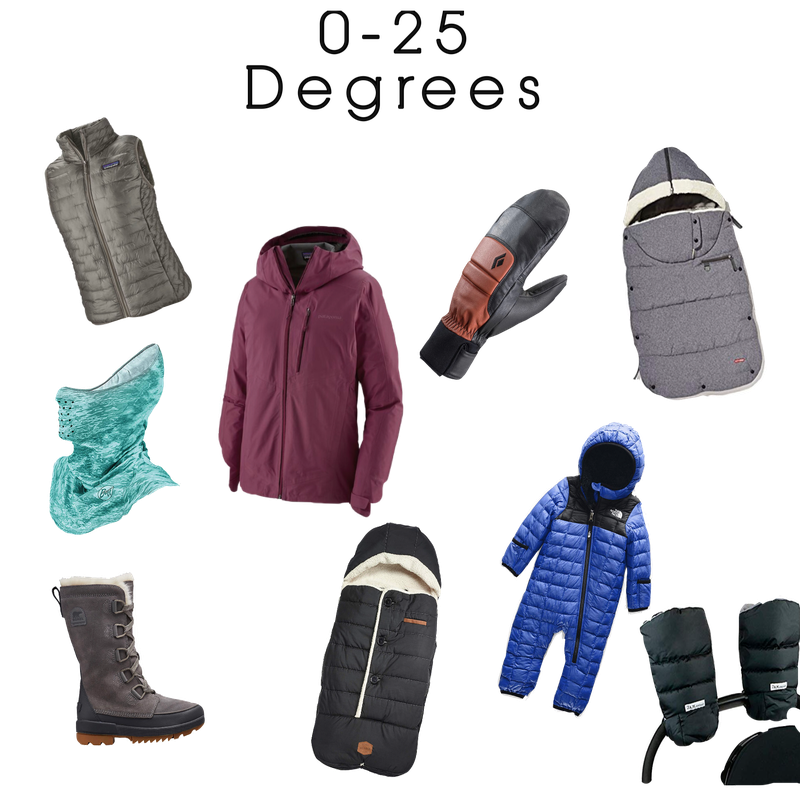
25 to 35 Degrees
While this range feels a bit safer, it is still pretty cold. Do not underestimate. I recommend dressing according to the program above, but perhaps eliminating the vest, heavy gloves, and extra insulating pants. That being said, I prefer to overdress and simplify than desperately wish I were better prepared. It’s incredibly easy to cool down if you’re hot, but not so easy to warm up when you’re cold. Equip yourself to ensure you never have to be chilly.
Baselayers
Same as 0-25 degrees recommendation. You can choose between wool socks or winter shoes, (probably don’t need both)
Insulating Layers
Don’t stress as much about multiple insulating layers; one should do.
For kids, the Youth Girl’s Benton Springs Jacket, Soft Fleece, Classic Fit is a great option.
Outer Layers/Shell
Jacket: Something similar to this Men’s CirruLite Down Jacket
Hat: Iksplor Little Explorer’s Hat, The North Face Baby Nugget Beanie
Boot: Kamik Kids Insulated Snow Boots
Gloves/Mittens: You can go lighter on the gloves. I’d stick with warm mittens for the kids but always pack an extra pair. The Hestra Heli Ski Junior Mitten comes highly recommended.
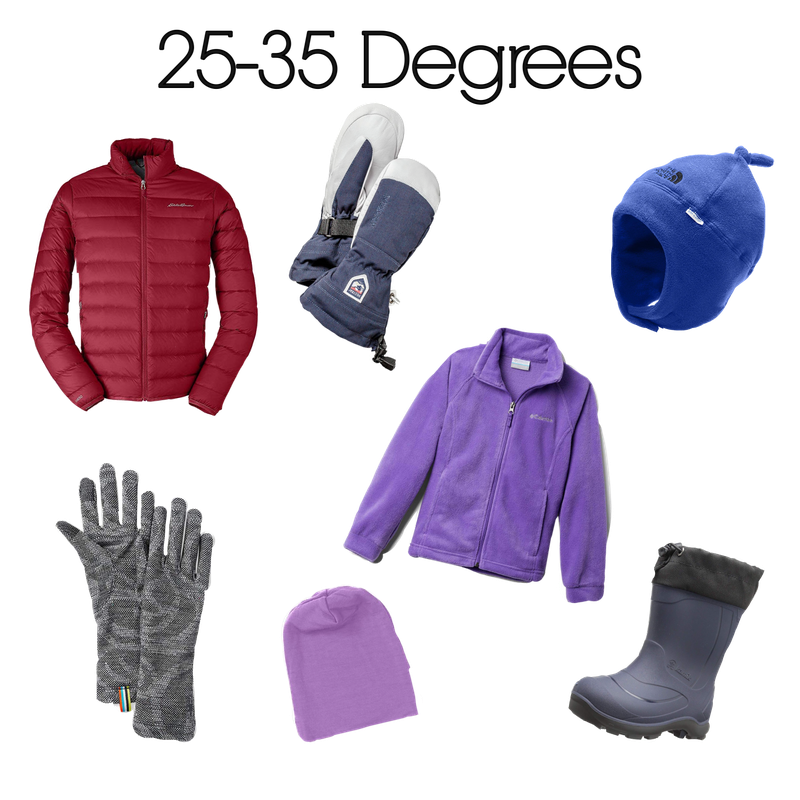
35 to 45 Degrees
In this territory, we are finally above freezing temperatures, so even though it’s cold, you can start to think more casually about what to wear. We call this sweater weather. For those of us who love a seasonal mentality, these are your stereotypical fall mornings. I recommend wearing whatever pants you’d like and then an insulated jacket with gloves and a hat. The sun will undoubtedly make or break your warmth so consider normal pants, jeans or leggings, a fleece or lighter puffy, and a hat and gloves.
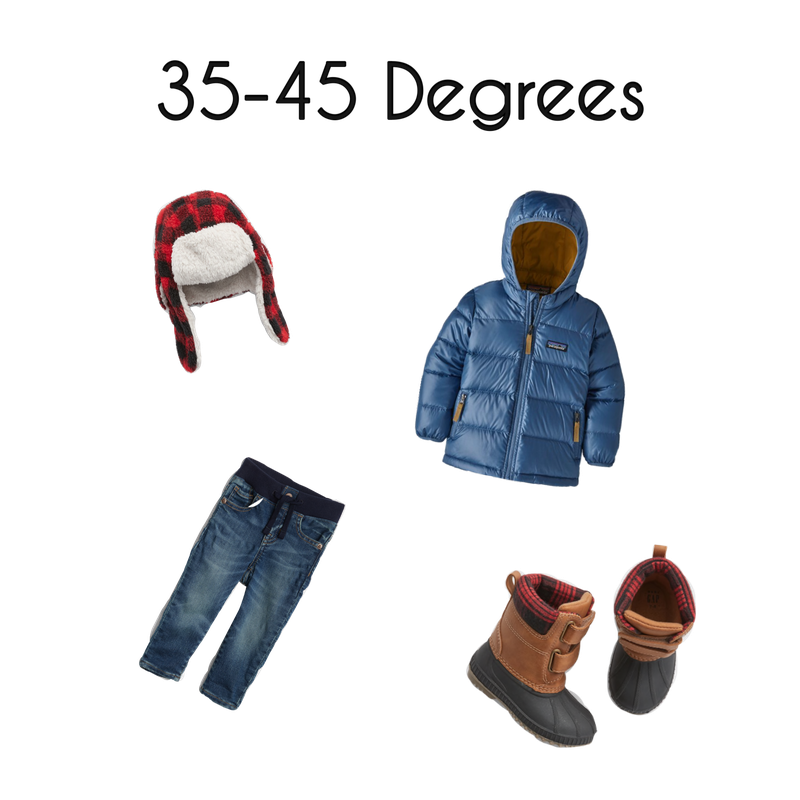
45 to 55 Degrees
It’s getting pretty comfortable around here. It’s still chilly, but you can switch to a light jacket because a simple insulating layer will do. Don’t stress too much about cold feet anymore, but still wear closed-toed shoes. However, you can let go of the wool socks and switch to something lighter.
Essentials: Normal shoes (no more wool socks), pants, long sleeve shirt, thin jacket or fleece, baseball or light-weight hat (depending on sun exposure).
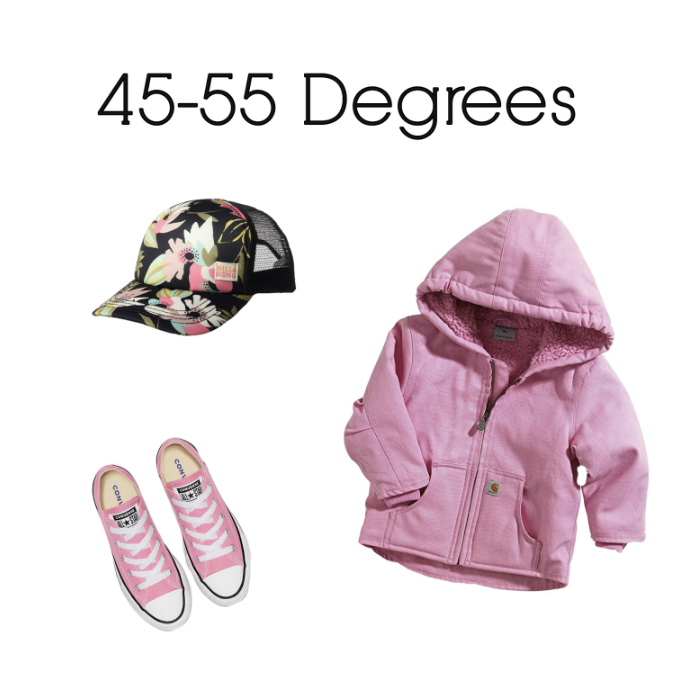
55 to 65 Degrees
Here is the sweet spot. Who can complain when you’re living in proper room temperature conditions? The World Health Organization calls 64 degrees the standard for comfortable warmth. Break out the shorts for active days and maybe use a vest over a light long sleeve for stationary comfort. When the weather is transitioning, layers are your friend. We live in a place where it can be minus 10 degrees in the morning and at least 40 in the afternoon. I always dress my family intending to add or remove layers along the way.
Essentials: At 58, start wearing shorts if you expect to be active, a long sleeve shirt and sweatshirt or vest/light fleece, and pants.
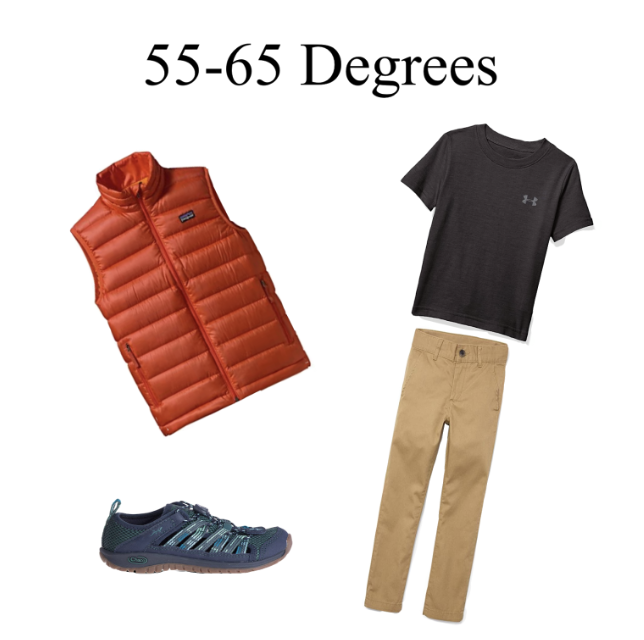
65 to 75 Degrees
It’s starting to get warm! This range is another hard one to hate. You are free of the extremes, and you can wear shorts/pants and a light shirt. Maybe break out the flip flops? The world is your oyster! We are also emphasizing sunscreen at this point. Sunscreen is essential no matter what temperature it is outside, but when it’s hot, and more of your skin is exposed, it becomes more critical than ever. If you prefer not to use traditional sunscreen, consider zinc or wearing a hat and UV protective clothing.
Essentials: Flip flops/sneakers/booties, shorts, polarized baseball hat, thin long sleeve shirt or sweater for layering
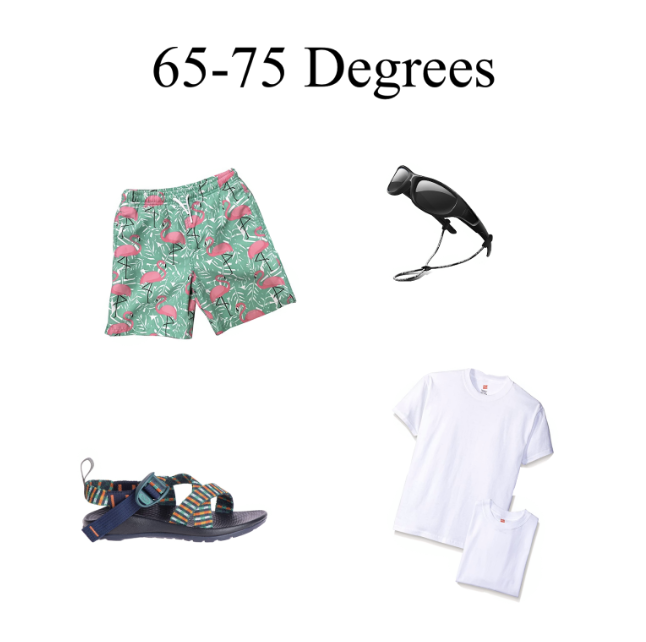
75 to 85 Degrees
This warmer weather is still lovely, but creeping on hot. Dress for summer, but consider bringing a long sleeve shirt if you’re going somewhere with AC.
Essentials: Sunscreen, a hat, sun protection, shorts, T-shirt or tank top, (choose a tech shirt over cotton), and a long sleeve shirt
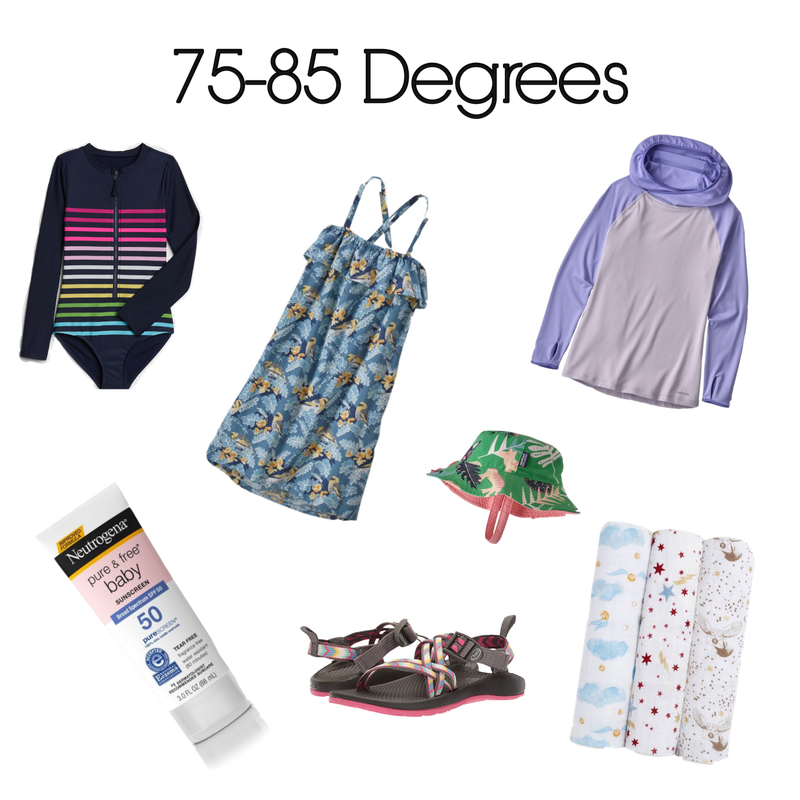
85+ Degrees
Okay, now it’s HOT. We are in summer territory, and we must consider our health and safety more when we prepare for our day. First and foremost, pack a ton of water. The last thing anyone needs is to get dehydrated. Always consider some sort of sun protection for your bodies and eyes. Lastly, have cool clothes and a bathing suit on hand! It’s time to hit the pool! Look for shade when you can.
Essentials: Sunscreen, water, shorts, tank top, t-shirt, swimsuit.
Aden and Anais Muslin Swaddles: These muslin swaddles are great beyond swaddling and work super well to keep little ones in the shade while still allowing for airflow.
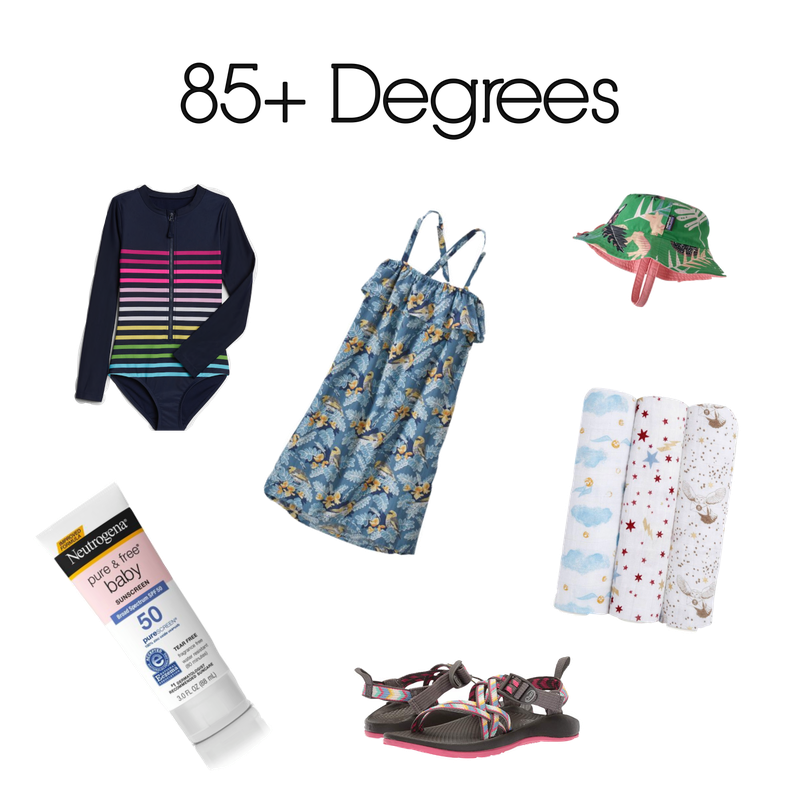
Rain
A light rain jacket is essential. We love the Hatley and Hunter kids options. They’re both cute and have nice lining so it's still comfortable when it starts to rain. Rubber boots, an umbrella, and a change of clothes in plastic bags for little ones are also important to have on hand.
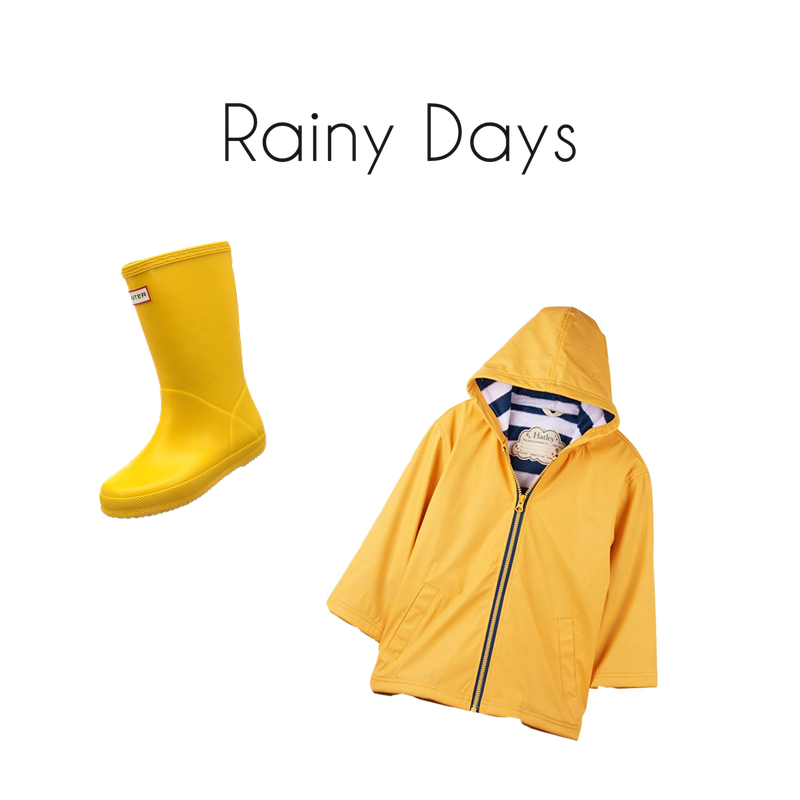
We hope these tips help make your outdoor adventures even more enjoyable. Please share your advice or favorite items with our village! There is a wide range of options available that serve the same purpose, and we cannot wait to hear about your favorites. Tag us on Instagram with your cute little kiddos, download our free app and check out our website for so much more fantastic content. Most of all, thank you, friends, for your overwhelming support.